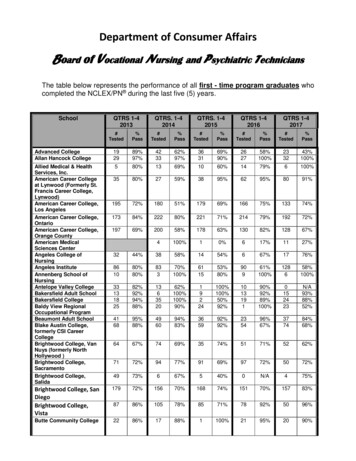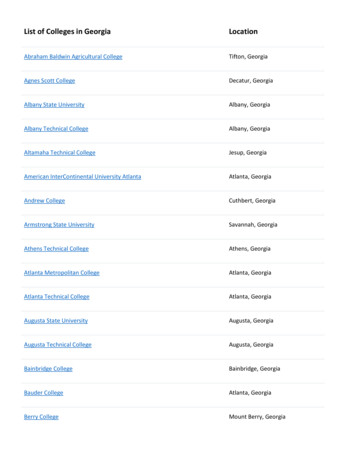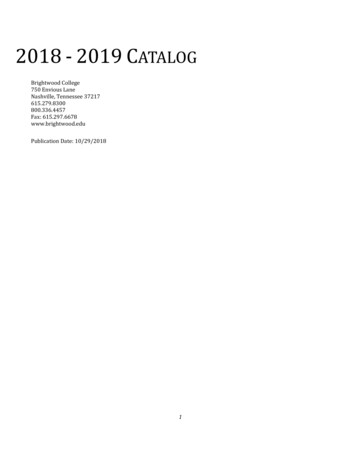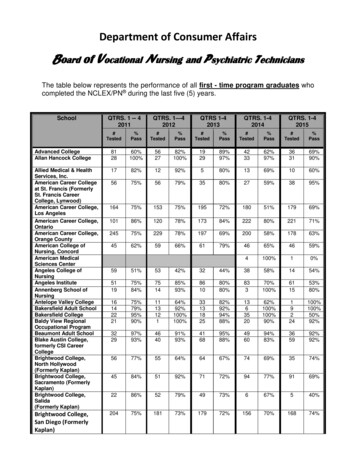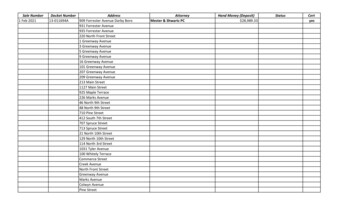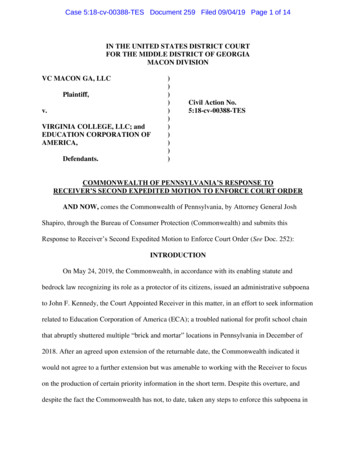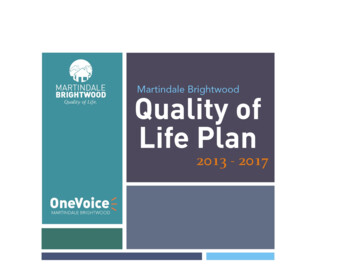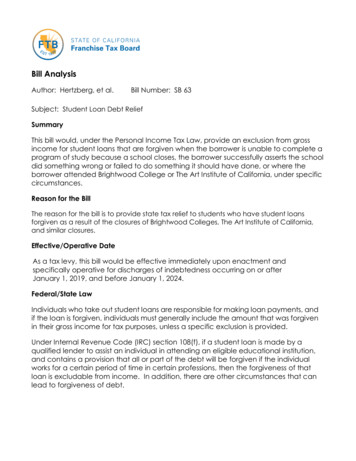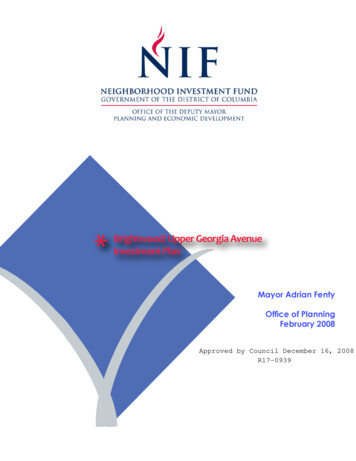
Transcription
Brightwood/ Upper Georgia AvenueInvestment PlanMayor Adrian FentyOffice of PlanningFebruary 2008Approved by Council December 16, 2008R17-0939
DC Office of Planning 2008
IIntroductionII Target Area BackgroundIII Creating the PlanIV Investment Goals &StrategiesAppendicesI Target Area MapII SurveyDC Office of Planning 2008page 3
DC Office of Planning 2008
introductionDC Office of Planning 2008
A Vision for Targeted Community InvestmentThe Neighborhood Investment Fund (NIF) is an annualnon-lapsing, revolving fund to finance economic development and neighborhood revitalization in 12 targetneighborhoods. Created by the District of ColumbiaCouncil in 2004, the Fund was designed to provide apool of resources to support investment and revitalization in emerging and distressed neighborhoods. Moreover, the Council envisioned NIF as contributing to abroader economic development tool kit to achieve acritical mass of investment needed to make a significantand visible impact in its target neighborhoods.Creating the FundThe District’s economic boom, which began in earnest in2000, brought significant public and private investmentto Downtown Washington. According to the Washington DC Economic Partnership, over 13 billion dollarshas been invested in projects completed since 2001 inWards 2 & 6 (primary Downtown DC area) with another 29 billion invested in projects under construction,planned or proposed. This investment has spurred arenaissance in the physical development of the city andalso a transformation of the District’s reputation in theregion, across the country, and throughout the world.Despite rapid changes downtown and in the adjacentTo that end, the District of Columbia Office of Plan- neighborhoods of Penn Quarter, Gallery Place, and Loning in partnership with the NIF Program’s imple- gan Circle, the majority of the District’s neighborhoods,menting agency, the Office of the Deputy Mayor for especially those East of the River, have been largely unPlanning and Economic Development, worked with touched by this growth. This well documented periodcommunity stakeholders in each target area to de- of uneven growth created a multitude of consequencesvelop an investment plan. The target area invest- from rapid escalation of housing costs, loss of affordment plan is designed to identify community pri- able housing stock, and further concentration of povorities for NIF investments and to set an investment erty in distressed neighborhoods of the District. Theagenda for NIF resources over a five year period. Neighborhood Investment Act was created in this context of raising the profile and importance of investing inThe following Brightwood Target Area Investment Plan District neighborhoods - its people, places, and assets.presents an overview of the NIF program, a backgroundof the target area, description of the planning process, The Neighborhood Investment Act of 2004 (NIA),and the resulting investment goals and strategies. Sig- which established the NIF program, was created outnificant community engagement through grass roots of several pieces of similar legislation proposed incommunity organizing lead by the Washington Inter- 2003 to provide resources for targeted neighborhoodfaith Network (WIN) was integral to the development investment. The initial thrust for creating a targetedof the plan and ensuring broad stakeholder support for investment program grew from community organizingits recommendations. These partnerships, fostered around making neighborhoods a top city priority andthrough the planning process, are integral to the imple- paralleled similar efforts such as the Strategy Neighbormentation of the investment plan, as many strategies can hood Investment Program developed by the Williamsonly be realized through community driven projects. administration. The Washington Interfaith Networkwas integral in advocating that the Council and theWilliams administration place “Neighborhoods First.”The NIA legislation created a non-lapsing, revolvingfund outside of the General Fund, called the Neighborhood Investment Fund (NIF). The NIF is fundedthrough an annual appropriation of 15% of a personalproperty tax, not to exceed 10 million. The NIA mandates that the Mayor prepare and submit to the Councilan annual spending plan for how the NIF will be utilized in the 12 neighborhood target areas designated inpage 6DC Office of Planning 2008
the NIA. The District of Columbia’s Office of the Deputy Mayor for Planning and Economic Development ischarged with implementing the Neighborhood Investment Fund program and the requirements of the NIA.nity, not for profit organizations, among other groups.The purpose of the Investment Plan is to set communitypriorities for how the NIF funds should be utilized inthe target area over a five year period. The InvestmentPlan, which is the subject of this report, fulfills the legThe target areas defined in the NIA legislation were islative requirement for the Brightwood target area.selected by the Council because of their status asemerging or distressed neighborhoods where targeted Operating the Fundinvestment would have maximum impact. There are Each year the Mayor submits a spending plan to Counciloutlining how the annual appropriation of NIF funds willbe utilized in the 12 target areas. The funds are intendedto be used on projects that realize the goals of economicdevelopment and revitalization in the target areas. Thespending plan can feature a diverse range of projectsthat will make significant investments in the areas ofeconomic development, community facilities, housing,education, job training and development. NIF also facilitates creative partnerships among District agencies,the non-profit sector and the private sector. Currently,there are five funding programs supported by the NIFthat provide grant and loan assistance for a range ofprojects. They include: Neighborhood Grants Program,Target Area Project Grant, Predevelopment Grant Fund,Land Acquisition Predevelopment Loan Fund, and NIFGovernment Projects. Future fiscal year spendingplans may include these programs or replace them withother initiatives that meet the goals of the NIF program.Typically, the Office of the Deputy Mayor for Planningand Economic Development releases a Notice of Funding Availability or Request for Proposals when funding for the program becomes available. Projects areNIF target areas in every Ward, except Ward 3. Theyselected based on the eligibility requirements of theinclude: Anacostia, Bellevue, Congress Heights, andprogram, the project’s public benefit, ability to leverageWashington Highlands in Ward 8, Deanwood/Deanresources, and catalytic effects. With this investmentwood Heights in Ward 7, H Street in Ward 6, Brookplan, projects in the Brightwood target area must beland/Edgewood and Bloomingdale/Eckington in Wardsupported by the community investment goals and pri5, Brightwood/Upper Georgia Avenue in Ward 4, Loorities identified in this investment plan. Future investgan Circle and Shaw in Ward 2, and Columbia Heightsments from the NIF will ensure the expenditures arein Ward 1. Subsequent amendments to the NIA in 2007compatible with the goals of this plan and that all NIFhave expanded the Columbia Heights, Deanwoodfunds are being utilized to implement its objectives.Heights and more recently the Brightwood/Upper GeorgiaAvenuetargetareas.NIF was established largely due to community organizing and its implementation relies on target areaOne of the requirements of the NIA legislation is forstakeholders becoming instigators of change withinthe Mayor to develop NIF Investment Plans for eachtheir own communities. The structure of the fundof the target area using input from community stakeempowers community stakeholder groups to applyholders including the Advisory Neighborhood Comfor funding to accomplish the goals of the plan. Bymissioners, residents, business owners, faith commuDC Office of Planning 2008page 7
utilizing the funding opportunities described above,these groups truly will become partners with the District is realizing change at the neighborhood level.Defining an Investment AgendaClearly not all of the goals identified in this investment plan can be or should be addressed solely by theNeighborhood Investment Fund. Many of the issuesraised through the planning process are long standingstructural issues that have impacted this target area formany years. The Fenty Administration is dedicated tousing the broadest range of District resources to addressthe problems of affordable housing, local retail development, public safety, education, among other issues.Therefore, the investment plan also includes recommendations where other District resources, such as the District’s capital budget, Housing Production Trust Fund,and Community Development Block Grants, could beutilized to achieve the goals of this plan. Moreover,NIF will be used to fill gaps in funding availability andapplicability of existing government programs. In thiscontext, the Fenty Administration envisions NIF as acritical tool within a comprehensive strategy to improveneighborhoods in the District.The following section provides an overviewof the target area, including a demographic portrait and current revitalization initiatives.page 8Businesses in BrightwoodDC Office of Planning 2008
DC Office of Planning 2008page 9
DC Office of Planning 2008
target area backgroundDC Office of Planning 2008
Brightwood Target Area ContextThe Brightwood/Upper Georgia Avenue Target area’s boundaries were legislatively ammended in December 2008 to includeKennedy Street and portions of Takoma and Petworth.The expanded NIF funding area is now bounded byFern Street and Fern Place to the north, Blair, Carroland Willow Streets NW to the East, Kennedy StreetNW to the South, and portions of 13th Street NW, Arkansas Avenue, NW and 16th Street NW to the West.See the expanded target area boundary on Page 22.Since the Council’s approval of this boundary expansion, the recommendations ofthisPlannow apply to these incldue new areas.Althoughthehometostableneighborhoods and a variety of community resources,Commercial activity is concentrated along Georgia Avenue, Kennedy Street and portions of 14thStreet. The zoning along these major corridorsprovides for both commercial and residential development and much of the existing development is realized in low-scale mixed-use buildings.Walter Reed Army Medical Center, anchored in thenorthwest area of Brightwood, will officially beturned over to the General Services Administrationand the Department of State in 2011. The closure ofWRAMC will provide significant redevelopmentopportunities for the neighborhood and the Ward.The Upper Georgia Avenue Land Development Planprovides guidance on the future development of the site.Transit access in Brightwood is supported by theGeorgia/Petworth Metro station to south of Kennedy Street and Takoma Station Metro to theBrightwood has been faced with a concentration of East. Metro buses connect the transit systemundesirable commercial uses and limited investment. with frequent bus service throughout the area.Many community residents and businesses have voicedtheir frustration that investment opportunities and Dis- Planning and Development Activitytrict resources within the community are long overdue. The Office of Planning has completed several landBrightwood residents are, however, optimistic about use and revitalization plans that provide a contextthe potential opportunities that this initiative may pro- for how NIF investments can support ongoing recvide, and will look to this investment plan as a catalyst ommendations and policies as indicated below:for change.1.District of Columbia Comprehensive Plan:Neighborhood DescriptionDistrict Elements, 2006: The BrightwoodThe land uses within Brightwood range from preneighborhood is covered within the Rockdominately low to moderate density residential buildCreek East Area Element of the Plan andings with commercial uses scattered along Upperprovides guidance on redevelopment strategiesGeorgia Avenue, 14th Street and Kennedy Street. Adand goals, calling out specifically the Upperditionally, various non-residential uses such as theGeorgia Avenue and Kennedy StreetWalter Reed Army Medical Center on the northwestcommercial corridors. The Kennedy Streetcorner and a myriad of churches, recreation centersRevitalization Plan and the Upper Georgiaand schools also provide services to this community.Avenue Great Streets Redevelopment Plan willbe presented to the Council of the District ofBrightwood is composed of single-family homes with aColumbia as Small Area Plans, which uponlarge number of multi-family properties clustered alongapproval will supplement the14th Street and Missouri Avenue. Duplex and attachedComprehensive Plan for the study area.single-family homes are the dominant housing type andare mostly concentrated in areas west of Georgia Avenue. 2.Strategic Neighborhood Action Plans (SNAP),The highest densities of attached homes are clustered2002: The Brightwood NIF area was coveredsouth of Missouri Avenue and east of Georgia Avenue.SNAPs for Clusters 17, and 18. Theseplans included recommendations for economicpage 12DC Office of Planning 2008
revitalization, creating the potential fornew residential, commercial andmixed-use development, and address publicsafety concerns, specifically for areassurrounding Kennedy Street. Overall theSNAPs focused on improving the quality oflife for area residents and businesses.3.Great Streets Initiative, 2005: In May 2005,the District Council launched thisinitiative, which is a multi-agency attempt toleverage public and private investments toenhance economic and communitydevelopment.4.Upper Georgia Avenue CommercialCorridor Plan, July 2008: This plan,recommended nodal developmentthroughout the corridor from Eastern Avenueand Decatur Street. Public improvementsthroughout the area, and the enforcementof commercial codes and propertyimprovement plans.5.Kennedy Street RevitalizationInitiative, July 2008: This plan proposes toprovide strategic guidance for economicrevitalization and overall improvements to thepublic realm.6.Takoma Central District Plan, January 2002:The purpose of this plan is to targetrevitalization initiatives to the burgeoningcommercial distrct in Takoma. The planincludes near and mid-term strategies foreconomic development initiatives.Household Demographic Information for BrightwoodThe median household income in Brightwood according to the Census Bureau was 52,779 in 2003.The median household map on the next page belowrepresents 2005 projection data at the Block Grouplevel (Claritas). Most households within the neighborhood earn between the 35,000 to 80,000 range.Households with higher incomes are east of GeorgiaAvenue and in the southwest corner of the neighborhood. Pockets of lower incomes are located west ofGeorgia Avenue, coinciding with a large cluster ofmulti-family properties and along Kennedy Street onthe southeast corner of the neighborhood. (See Map 1)DC Office of Planning 2008The Department of Housing and Urban Development(HUD) developed the chart on page 15 (Source: Brightwood Neighborhood Investment Plan (TRF/WIN,2007) to compare household incomes to the District’sAverage Median Income (AMI). When comparing theBrightwood median household income to the different incomes levels defined by HUD, the typical household in Brightwood falls within the category, LowIncome level, or 60% to 80% of area median income.page 13
MAP 1: Brightwood Median Household Income (Claritas 2005)(Source: Brightwood Neighborhood Investment Plan, 2007 TRF.WIN)page 14DC Office of Planning 2008
Brightwood Residential Sales PricesAverage residential sales prices from July 2004 to July2006 range from 150,000 to 450,000. The following 2.table describes the sales activity in Ward 4 in comparison to the District.Table 2: Household sales prices for the District andWardArea C: Bounded by Aspen Street to the north,and Missouri Avenue to the south. Thearea is predominantly residential and containsthe highest concentration of multifamily structures in the neighborhood(1,117 properties, 13% of are multi-family),which are mostly clustered along 14th Street.4.Area D: Located on the eastern side ofBrightwood, bounded by Piney Branch Roadto the north, Upper Georgia Avenue to thewest, 5th Street to the east, and MissouriAvenue to the south. This area contains 1,718properties, 2% of which are multi-family;it is the lowest in Brightwood. Themedian sale price (07-01-04/07-10-06) forArea C is 364,250.A closer look at the trendsIn an effort to further analyze the housing trends forBrightwood, the neighborhood was divided into 5 distinct areas. Each area was defined based upon unique 5.and natural physical characteristics (See Maps 2 and3, Source Brightwood Neighborhood Investment Plan,2007 TRF/WIN)):Area A: Located in the southwest corner ofBrightwood, bounded by Missouri Avenue tothe north, Upper Georgia Avenue to the east,16th Street to the west, and Kennedy Streetto the south. This area contains 712properties, 11% of which are multi-familystructures, which are mostly clustered alongMissouri and Colorado Avenues.The median sale price (07-01-04/07-10-06) forArea A is 515,000; it is the highest in Brightwood.DC Office of Planning 2008Area B: Located in the southeast corner ofBrightwood, bounded by Missouri Avenueto the north, Upper Georgia Avenue to thewest, 5th Street to the east, and KennedyStreet to the south. This area contains 592properties, only 6% of which are multifamily structures. The median sale price(07-01-04/07-10-06) for Area B is 226,900;it is the lowest in Brightwood. Most of thehousing stock in this area is composed ofattached rowhomes.3.(Source: Brightwood Neighborhood Investment Plan, 2007 TRF.WIN)1.This area contains mostly large singlefamily detached homes.Area E: Area E is located on the north eastcorner of Brightwood, bounded by PineyBranch Road to the south, Upper GeorgiaAvenue to the west, 5th Street to the east, andFern Place to the north.page 15
MAP 2: Neighborhood Areas Housing ProfileSource: Neighborhood Investment Plan, TRF/WINpage 16DC Office of Planning 2008
MAP 3: Neighborhood Areas Median Sales PriceSource: Neighborhood Investment Plan, TRF/WINDC Office of Planning 2008page 17
DC Office of Planning 2008
creating the planDC Office of Planning 2008
Brightwood Needs Assessment and Investment Priority Developmentof the Deputy Mayor for Planning and Economic Development for consideration. OP assessed the plan andbuilt upon it by incorporating additional community inMethodologyput and a review of the District’s existing land use plansFrom October 2005 to October 2006 The Washington and polices.Interfaith Network (WIN) and The Reinvestment Fund(TRF) worked with member churches, residents andcommunity organizations to create an investment plan Neighborhood Reinvestment Goals (Source: Brightthat would drive NIF funding within the Brightwood wood Reinvestment Plan, TRF/WIN 2007)community. This plan, used input from the communityand detailed data analysis to determine how NIF funding should be prioritized.TRF used a community questionnaire to collect data regarding the current needs of Brightwood and facilitatedtwo community workshop meetings in which residentsworked in groups on a mapping exercise designed tocollect specific information about issues and improvements that are needed throughout the neighborhood.Additionally, TRF underwent a comprehensive assessment of housing and demographic trends of the Brightwood NIF area. TRF analyzed the end results of bothefforts to create the following NIF Goals and Actions:WIN Strategic Goals and Actions1.Establish a WIN/EBOL Neighborhood Development Action Team to implement strategic actions & hire a Community Developer.2.Assign a District’s Real Estate DevelopmentProfessional to act as a Project Manager & Liaison between WIN’s Neighborhood Development Action Team and City Agencies.3.Create New Affordable Homeownership &Rental Housing along commercial corridors.4.Preserve Affordable and Subsidized RentalHousing.5.Implement and/or create new programs to support existing homeowners in property maintenance.6.Improve the physical condition and retail choices along Georgia Avenue and Kennedy Streetthrough the creation of a TIF (Tax IncrementFinancing).Based on their community engagement, WIN andTRF formulated and submitted an Investment Plan forBrightwood to the Office of Planning and the Officepage 20DC Office of Planning 2008
strategies in detail. Each goal and strategy was analyzedand cosigned by the group before moving on to the nextitem. Then, each member of the group was given threecolored dots and asked to place one dot next to whichever item they felt deserved the highest priority. Theresults of this meeting further expounded upon the previous set of priority areas in which the community feltwere important and should receive precedence whenNIF funds are allocated. The investment strategies thatfollow, include the results of this community meeting,and incorporate an analysis of trends within the BrigthBased on the review of these existing plans and the WIN wood neighborhood.submission, OP crafted the following goals for housingaffordability and economic revitalization to serve as a Brightwood community residents engaged in a planframework for obtaining input from the community on ning meeting:NIF investments:1.Creation of new affordable housing options;2.Preservation of existing affordable housingstock;3.Support programs for low-incomehomeowners; and4.Support programs for economic developmentand street beautification.Office of Planning AssessmentThe Office of Planning compared WIN’s StrategicGoals and Actions to existing planning policies and activities to determine if any of these focus areas wereraised during past planning activities. During this assessment, OP found that many concerns about housingaffordability and economic revitalization—especiallyin Brightwood-- are still valid and are addressed inplans and polices highlighted in Section 2.Community InputIn addition to reviewing existing community plans,OP staff also held one public NIF investment strategyworkshop to hear the community’s perspective on whatinvestments are needed in the target area and more importantly which of these investments should be prioritized when NIF funding is allocated over the next twofiscal years. The meeting was held on January 10, 2008 As part of the community meeting it was also noted thatat Emory Beacon of Light, with approximately 60 resi- the Brightwood NIF boundary should be expanded toinclude and coincide with portions of the now approveddents attending.Kennedy Street Revitalization Plan, July 10, 2008. TheDuring this meeting, OP presented the four primary community felt that NIF resources should be extendedgoals above and included specific strategies through to areas of the Ward that were intended to have ecowhich these goals could be implemented using NIF nomic revitalization and housing affordability initiafunding. The purpose of the meeting was to determine tives. After the plan was developed, Councilmemberif the goals and the strategies were on the right track Muriel Bowser recognized an opportunity to furtherand to ask participants to identify which goals and/or expand the Brightwood NIF boundaries to include porstrategies should be considered a priority over the next tions of Takoma and Petworth, which have similarlytwo fiscal years. The public was also given the oppor- suffered from limited investment and undesirable comtunity to offer new goals or strategies they felt needed mercial uses.to be addressed, that may not have been included in theIn December 2008, the Council introduced legislationinitial plan review.to redefine the Brightwood NIF area to include portionsFacilitated by OP staff, the participants worked in of Kennedy Street, Takoma and Petworth as follows:groups where they discussed the investment goals andDC Office of Planning 2008page 21
page 22DC Office of Planning 2008
Target Area #6 -- Brightwood and Upper GeorgiaAvenue. The Brightwood and Upper Georgia Avenue target area is defined as starting at the corner ofKennedy Street, N.W., and 16th Street, N.W., northalong 16th Street, N.W., to Alaska Avenue, N.W.,northeast along Alaska Avenue, N.W., to Fern Street,N.W., east along Fern Street, N.W., to Georgia Avenue N.W.,north along Georgia to Fern Place, N.W.,east along Fern Place, N.W., to Blair Road, N.W.,southeast along Blair Road, N.W., to North CapitolStreet, N.E., south along North Capitol, to KennedyStreet, N.W., and west along Kennedy Street, N.W.,to 13th Street, N.W., south along 13th Street, N.W.to Arkansas Avenue, N.W., south along ArkansasAvenue to 16th Street, N.W., north on 16th StreetN.W. to Kennedy St. N.W.”This boundary expansion was approved by the Councilon December 2, 2008 and the recommendations of thisPlan now apply to these new areas.The next section presents the final Investment Goalsand corresponding strategies that will be used to direct NIF resources over a five year period. Each goalis followed by a set of specific strategies that point tohow NIF resources may be utilized to accomplish thegoal. It is also noted where other District resourceswould contribute to implementing the investment planand achieving the overall objective of the NIF program.The investment strategies are purposefully broad to encourage flexibility in the types of community initiatedprojects that could be funded through the multiple grantand loan programs under NIF.DC Office of Planning 2008page 23
DC Office of Planning 2008
investment goals &strategiesDC Office of Planning 2008
NIF Investment Goals & StrategiesAffordable HousingThe Brightwood target area features traditionally stableresidential neighborhoods anchored by two emergingcommercial corridors of Georgia Avenue and KennedyStreet. The residential neighborhoods of Brightwood,Shephard Park Takoma and Brightwood Park, collaboratively, offer a wide range of housing options fromsingle family to multi-family apartment buildings;however, there are limited sites for new housing development within these neighborhoods. The greatestpotential for new development is along the commercial corridors of Georgia Avenue and Kennedy Streetwhere mixed-use development can bolster retail opportunities, and also encourage the creation of affordablehousing. The land use plans for Georgia Avenue andKennedy Street provide a strategic tool to guide futuredevelopment. Resources such as NIF should be usedto support the revitalization efforts anticipated for bothcorridors.The preservation of existing affordable housing options is also a top priority within the Brightwood NIFboundary. This includes monitoring and preserving thefederally subsidized rental housing stock, in additionto supporting long time homeowners maintain theirhomes. Clearly the affordable housing challenges inBrightwood can not be addressed by relying on onlyNIF resources. NIF funds should complement otherDistrict programs and funding sources that can support the following three housing goals on the followingpages.page 26DC Office of Planning 2008
Goal #1—Creation of new affordable homeownership options and rental housingoptions along commercial corridors.Strategies to implement Goal # 1:a)Use NIF funds to acquire vacant and or underutilized lots for redevelopment as mixed-useretail and affordable housing.By comparing data from the Office of Tax and Revenue, the Department of Consumer and RegulatorAffairs and to the WIN plan recommendations, vacant and underutilized properties withinBrightwood can be identified and prioritized for acquisition. Redevelopment initiatives should focus onthe production of new affordable housing and ground floor retail. There are approximately20 properties along Georgia Avenue between Van Buren and Missouri and 15 properties alongKennedy Street between Georgia Avenue and North Capital Street NE, that would be optimal formixed-use redevelopment. NIF’s grants and loans should be utilized by eligible developers toaccomplish this strategy.b)Identify underutilized parcels or buildings located on or near major commercialcorridors that could be acquired and redeveloped as senior or special needs housingfacilities.A need for senior housing facilities that allow persons over the age of 65 to age in place has beenidentiied and the community has expressed a desire to see these facilities located along the activecommercial corridors such as: 14th Street, Georgia Ave, or Kennedy Street. Locations suchas these would give the senior population access to basic retail needs, services and easier access totransportation. Directing funds toward the development of senior housing through NIF resources andworking alongside the DC Department of Health’s Health Care Facilities Division would enable localorganizations to provide housing for seniors of all activity levels.c)Include Brightwood as a target area to receive DHCD’s NOFA and market information to thecommunityThis strategy is intended to target investment into this NIF area by identifying it as a priority area in theDepartment of Housing and Community Development’s bi-annual Notice of Funding Availability(NOFA). The NOFA alerts eligible developers to the availability of housing financing forconstruction, rehabilitation and acquisition of housing and community facilities across the District.By targetng Brightwood, there is the potential to leverage NIF predevelopment and acquisition fundswith other housing resources to accomplish the goals of this investment plan.DC Office of Planning 2008page 27
Goal #2: Preserve existing affordable rental and homeownership within BrightwoodStrategies to implement goal:a)Market existing programs, tools, and services and create new ones that increasehomeow
5, Brightwood/Upper Georgia Avenue in Ward 4, Lo-gan Circle and Shaw in Ward 2, and Columbia Heights in Ward 1. Subsequent amendments to the NIA in 2007 have expanded the Columbia Heights, Deanwood Heights and more recently the Brightwood/Upper Geor-gia Avenue target areas. One of the requirements of the NIA legislation is for
